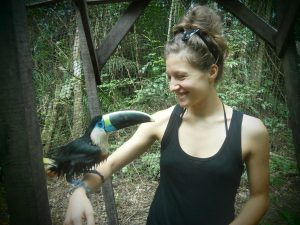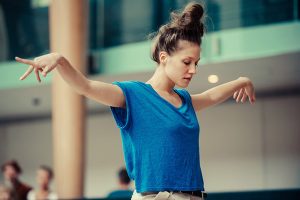Surrealist lobsters, a medieval dancing plague in Strasbourg, modern Ethiopia – these are a few of the eclectic ideas infusing the work of award-winning and boundary-pushing dance artist and choreographer Lucy-Margaux Marinkovich.
Since graduating three years ago with a Bachelor of Arts majoring in English literature, she has been unstoppable. As well as setting up her own company Borderline Arts Ensemble, she’s been in demand at home and internationally to teach, perform and choreograph, working with professional dancers, school kids and people with disabilities alike.

Lucy Marinkovich with a toucan at a wildlife rehabilitation centre in Peru, during a three-month stint volunteering in South America. She was studying English literature by distance at the time.
Following a month in Taiwan and Japan early this year supported by Creative New Zealand to research future collaborative opportunities for new dance and choreographic work, she was back home in Wellington at the end of summer for the opening of her new work, Thursday. This romantic duet, inspired by the 1945 British film classic Brief Encounter, premiered in the Performance Arcade at Wellington Railway Station amidst the travellers, passengers and commuters.
In a slightly more bizarre take on love and attraction, Lobsters was the title of a daring work she created, choreographed and performed in at Circa Theatre, Wellington in 2017. Inspired by the surrealists’ theories and artworks, including Spanish artist Salvador Dali’s infamous Lobster Telephone (also known as Aphrodisiac Telephone, 1936), it won three Wellington Theatre Awards and was also performed at the Nelson Arts Festival, earning rave reviews. Other works she’s choreographed and directed for Borderline include Good Good Fortune (2016-17, Singapore, New Zealand, Malaysia) and The Shyness of Trees (2017, Singapore).
Marinkovich began studying by distance with Massey while she was a full-time member of Footnote Dance Company, touring through Aotearoa and overseas yet making time to write assignments for anthropology, history, classics and women’s studies papers.
“I was taking papers extramurally whilst in Palestine and Israel for dance workshops, when I backpacked through Vietnam, while I was studying at a dance intensive in Berlin and whilst I was teaching at the New Zealand School of Dance, and at the same time that I was presenting my choreographic works at dance festivals and performance events in New Zealand,” she says.
In early 2018 she performed as a guest artist with the New Zealand Dance Company in OrphEus – a dance opera, choreographed by Michael Parmenter and performed in the New Zealand Festival and the Auckland Arts Festival. The day after the last show she flew to Christchurch to begin a job with the Royal New Zealand Ballet as its dance educator, teaching dance to students aged four to 18 in New Zealand schools, including NCEA workshops, and reaching more than 30,000 New Zealanders with dance activities.
“There was a large community aspect to this role that I loved, beginning training to teach dance to people with Parkinson’s disease, and facilitating the Royal New Zealand Ballet’s Touch Tours for blind and vision-impaired people, which were held alongside the audio-described performances.”
Midway through last year, she choreographed a new work for the New Zealand Dance Company for its Tamaki Tour called Awesome Robots, inspired by a research trip that Marinkovich took with her partner, composer Lucien Johnson, to Ethiopia in 2016. The work explored themes of Afrofuturism, science fiction and retro aesthetics, with costumes designed by Kate Hawley in the form of dazzling patterned suits and dancers wearing LED glasses.
The culmination of all this came at the end of 2018 when she was jointly awarded – with Johnson – the prestigious Harriet Friedlander Residency, worth $100,000, by the New Zealand Arts Foundation. This enables the pair to live in New York “for as long as the money lasts us!”
The residency was designed by arts patron Harriet Friedlander for artists to live in, and be inspired by, her favourite international city. “Being recognised by the Arts Foundation is the highest accolade for an artist from Aotearoa, and being granted one is made even more special by the fact that you cannot apply for these awards – you just get a magical phone call offering you this incredible thing,” says Marinkovich, who started taking ballet classes as a kid. “I am still pinching myself!”
More fantastical ideas and visions abound in her choreographer’s imagination. In April she’ll begin developing Borderline Arts Ensemble’s next full-length show, Strasbourg 1518. It’s inspired by the true events of a dancing plague that struck Strasbourg in 1518, in which dozens danced themselves into a frenzy for days without rest, resulting in a number of deaths.

Lucy Marinkovich performing (An Ironic Dream of) A Common Language by Kristian Larsen for Footnote Dance Company at the Auckland Art Gallery.
Her work, she says, reveals how a tertiary degree that fosters a love of literature, complex, challenging ideas, and a curiosity for weirdly fascinating historical and biographical stories, can help inform and inspire a bold, edgy approach to making art.
“I know that I don’t make art because I have answers that I feel compelled to share with everyone, but because I have questions,” Marinkovich says, when asked about what inspired Lobsters. “I question how we treat each other, how we communicate, how we hurt, how we love, how we look, how we feel. My body of work has a strong interest in the absurd and the irrational and how these manifest in everyday life.”
For more information on Marinkovich’s work visit: lucymarinkovich.com/blog. For her company Borderline visit: borderlinearts.com/lucy-marinkovich